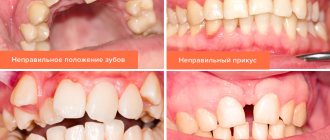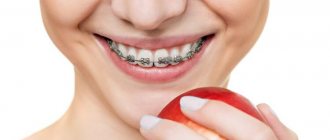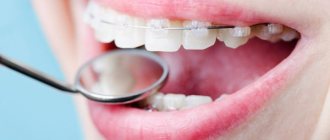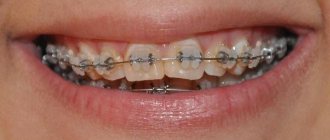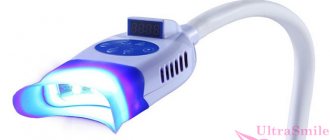The closer the completion of the procedure for wearing braces is, the more often patients are haunted by thoughts about how braces are removed, what features, and possibly complications this process is associated with. For some, such a question is just a matter of banal human curiosity, while others are seriously worried about the progress and consequences of this procedure. It is the hardest for those whom nature has endowed with a wild imagination, and these people can begin to vividly imagine the removal of braces, the resulting painful sensations, and the like. In fact, there is nothing terrible or dangerous in this procedure; moreover, removing the system is common and in many ways simple.
Let's take a look back
To get an idea of how braces are removed, you should remember how the system is secured in the patient's mouth. In this case, the key role is played by fixing preparations, which are very similar to the filling material familiar to many. First, the tooth must be cleaned of plaque, treated with a special liquid, and a bracket placed on a soft and pliable material. What happens next depends on the material used by the orthodontist: if it is photo-curable, it will set in a matter of seconds with the help of an ultraviolet lamp, but if a chemical substance is used, then the waiting time will be several minutes until it hardens.
Subtleties of the process
The procedure itself is relatively comfortable, painless for the patient, and takes significantly less time when compared to installing the system. The whole process consists of the following steps:
- Preparing instruments for work (tweezers, orthodontic pliers, forceps, lip pads).
- Installation of a retractor in the patient’s mouth , protecting the mucous membrane from accidental damage and providing free access to the dentition.
- Alternate opening of locks . If the fastening is ligature, the specialist immediately removes the ligatures.
- Removing the archwire from each bracket slot .
- Sequential removal of locks . To do this, the part is grabbed with forceps and moved by force.
Important! The manipulation must be performed extremely carefully so as not to damage the enamel coating and not cause the bracket to break.
Grinding
Remnants of dental glue are removed from the enamel surface using a special nozzle and paste, and then a remineralizing composition based on fluoride and calcium is applied.
The time a patient spends in the clinic and the quality of the procedure largely depend on the characteristics of the braces model. So, if the structure is made of sapphire or ceramics, every wrong movement can lead to crumbling of the elements.
In addition, ceramic/sapphire products take longer to remove and require a specialist to constantly monitor their actions. Metal systems are easier to remove.
Moreover, the fixation of expensive models differs from budget ones in greater reliability, which means that it will take more time to remove the plates and arc.
Lingual devices are more difficult and take longer to remove due to the inconvenience of their location and insufficient visibility. Only experienced specialists can perform all actions correctly.
If we consider vestibular structures, then non-ligature models are removed faster , since they are distinguished by the ease of removing the arch from the fastening mechanism.
How are braces removed?
Removing braces is much faster than installing them and does not cause any pain to the patient. First, the orthodontist removes the curing material, this is done mechanically using dental forceps. Each lock of the system must be opened so that the orthodontic arch can be released, and after this each bracket is removed from the teeth. This procedure is performed with the application of certain mechanical forces, so some discomfort for the patient is quite logical, but everything lasts quickly, within one or two minutes, so you won’t have to endure these not very pleasant sensations for a long time.
The dental glue is removed along with the braces, and its remains are cleaned off by the doctor using polishing machines. At this moment, not very pleasant sensations may also arise, but nothing more. This procedure usually takes no more than five minutes. The longest time you have to deal with is the lingual brace system; it takes about 30 minutes to remove it; in situations with ligature structures, everything is done much faster.
Duration and sensations
The average duration of the procedure is 30 minutes. This time is enough to remove the conventional system. If the lingual structure is removed, it takes more time - at least an hour.
By this time you need to add another 5-7 minutes, which will be required for grinding the enamel, and about half an hour for additional procedures (fluoridation or calcination).
The patient does not experience any painful sensations during the procedure (they occur only when he is restless). There is only some discomfort (manipulation of non-dental surfaces with instruments can hardly be called pleasant), especially when the enamel is polished.
After removing braces, many people begin to experience loose teeth. This condition is short-term and is considered normal by orthodontists. This is explained by the fact that the dental elements cease to feel the support (i.e., the apparatus).
Important! After grinding the enamel, sensitivity may increase. Carrying out restorative procedures and following the doctor’s recommendations will help quickly eliminate this phenomenon.
Let's figure out whether wisdom teeth are removed before installing braces, and when this procedure can be avoided.
In this article, read what to do if you swallow a brace.
Here https://www.vash-dentist.ru/ortodontiya/breketyi/vidyi-nadkusochnyih-plomb.html we will discuss why bite fillings are needed with braces.
Features of removing the bracket system depending on its type
The easiest way for an orthodontist to work on the process of removing metal braces is that sapphire and ceramic braces create a little more difficulty and time in this regard. The reason lies in the fact that the adhesion of these systems is stronger and stronger than that of metal ones; this has a favorable effect on treatment, since accidental unsticking of the bracket is almost completely excluded. At the same time, removing these systems requires the orthodontist to exert more effort, and therefore the patient has to experience not the most pleasant sensations. They are also associated with the risk of chipping and breaking the structures themselves, because they are more fragile than metal ones. This does not create any serious problems, it will just take a little more time for the technician to remove the system.
Arches for braces, their cost and types according to the material of manufacture
Based on the material used, arcs are divided into the following types:
- Stainless steel. This is the standard option and is the most popular. It combines quality and low price. Steel is elastic and has a high degree of rigidity. At the beginning of orthodontic treatment with braces, a woven steel arch is used, and then a solid one.
- Titanium with molybdenum. In the middle of treatment, this type is established. They are both elastic and tough. This alloy is less likely to cause allergies and minimizes possible discomfort while wearing braces.
- Titanium with nickel. These are much more elastic than the previous ones and less rigid. They are used at the initial stage.
- Alloys of copper, nickel and titanium.
Important! The decision to use one or another type of metal or alloy is based on the degree and type of pathologies and individual characteristics of the patient.
Arcs are also distinguished according to the type of section:
- Round - thin and elastic. They are used at the beginning of correction, as they have the smallest force on the teeth. Such specimens are thermodependent (they change qualities and properties when heated and cooled). While wearing, doctors advise not to eat foods with different temperatures at the same time, for example, cold yogurt and hot coffee.
- Rectangular - characterized by medium rigidity and traction force, so a rectangular arch is used in the middle of treatment.
- Square ones are the toughest. They completely fill the grooves of the braces. Used only at the end of correction.
Photo 1. A rectangular arch on the upper jaw, unlike a round arch, its interaction area is larger, and accordingly the force applied to the tooth increases.
DETAILS: How long does it take to make braces?
How much do wires for braces cost? The average price of one piece is 600 rubles.
How is tooth enamel polished?
You should not be afraid of grinding your tooth enamel after removing the braces; this is a normal procedure that is not associated with any difficulties or complications. The orthodontist, using polishing attachments, removes the remaining adhesive from the teeth in a circular motion and polishes the enamel. When the structure is removed, pockets of demineralization often form around the braces, which can be easily eliminated with a paste containing calcium and fluoride; if the need arises, teeth whitening can also be performed.
Cost of dental braces removal procedure
The average price for removing braces in Russia is 10,000 rubles ($154 at the time of writing). In general, prices vary depending on the clinic and city. The lowest price we were able to find was 3,000 rubles for one jaw (about $46), the maximum was five times more. Unfortunately, the pricing policy does not always reflect the quality of the services provided.
Cost of removing braces
In Ukraine, such services are much cheaper. For example, making a retainer will cost you 700 hryvnia. That's about $27. In St. Petersburg, the production of a retention mouth guard will cost 7000-8000 (108-123 usd). The cost of a mouth guard also depends on the material. For example, if it contains a reinforcing metal arc, such a product will be more expensive than an analogue made from a biopolymer without metal parts.
Average prices for orthodontic treatment:
| Name | Price |
| Consultation | 1140 rubles |
| Casts | 1140 rubles |
| Braces (1 dental arch) metal | 34200 rubles |
| Braces (1 dental arch) ceramic | 64600 rubles |
| Braces (1 dental arch) lingual | 88160 rubles |
| Arc installation | 3420 rubles |
| Re-bonding the bracket | 1216 rubles |
| Removing the bracket | 2660 rubles |
| Teeth whitening (using aligners) | 11400 rubles |
How to prepare for braces removal and how long does the procedure last?
There is no need for any special preparation on the part of the patient who will soon lose his braces. In fact, all that is required of him is to stock up on a little time and a little more patience, since he will still have to face some small unpleasant moments. The fact that the structure has been removed does not mean that the patient can leave the dental chair with a clear conscience. Do not forget about cleaning your teeth and polishing the enamel, the need to coat your teeth with remineralizing drugs, as well as installing a retainer.
You will have to spend at least 10 minutes on the removal of the system itself, this is in the simplest cases, then from 5–10 minutes, usually more, up to half an hour, will need to be spent on treating the teeth, plus approximately the same time will be spent on installing retainers . In total, it turns out that the minimum duration of a visit to the dentist’s office to remove braces will be about 40–45 minutes.
What to do if you swallow a wire from a brace 2 cm or more
If the wire has curved edges, it will not cling to soft tissue and will come out of the body painlessly. Problems arise if the ends are not rounded. It can dig into the tissue of the esophagus or even puncture it, which will lead to internal bleeding.
Important! Be sure to call an ambulance. If there is pain or discomfort, the patient is usually taken to the hospital and an x-ray is taken to determine the location of the segment and remove it.
If the segment is small, the part may not be removed, but the patient may be left in the hospital so that everything comes out naturally under the supervision of doctors.
Before the ambulance arrives, you need to follow the recommendations:
- Try to move less and not push it down the esophagus with sips. Drinking is allowed, but very carefully.
- Don't eat to avoid making the situation worse.
- Do not induce a gag reflex so that the piece does not injure the esophagus.
In addition to archwires, people also accidentally swallow ligatures or individual braces that have become detached from their teeth. In this case, there is no need to worry. They will either dissolve in the gastric juice or be released naturally.
Does it hurt?
It is not difficult to understand the fear of pain in patients who are about to part with their braces, but it should be said that during this procedure the doctor does not touch either the soft tissues of the oral cavity or the tooth enamel, except for grinding it after removing the structure. Accordingly, pain is almost completely eliminated, but the likelihood of this unpleasant phenomenon still exists and here’s why:
- During the process of removing braces, the patient becomes overly nervous, spins around in the chair and thereby increases the risk of injury;
- when separating the clasps from the tooth surface, discomfort may occur if the connection of the tooth with the glue is too tight;
- During grinding of enamel, pain may occur as a result of the grinding disc touching the gums, however, this is a consequence of the patient’s restlessness in the chair.
How is the pick-up done?
Removal of braces is carried out by an orthodontist in a dental office.:
- Before starting work, the specialist installs a retractor in the patient’s oral cavity. We are talking about a fixing pad that prevents the involuntary closure of the jaws. The device will protect the oral cavity from damage.
- Using special tweezers, the orthodontist begins to remove the bite-correcting dental braces. First of all, the specialist removes the metal rings that serve as fasteners for braces. They securely fix the arc.
- After removing the metal rings, the doctor begins to remove the arc itself. Using orthodontic forceps, he removes the locks, the working part of which tends to securely grip the wings of the bracket. The doctor carefully places the instrument on the upper and lower wing. Then he squeezes the pliers lightly to bend the bracket. When deformed, it will easily move away from the surface of the tooth without damaging the latter.
- Having completed the manipulation of removing the locks, the specialist begins to remove the remaining cementing material. This substance remains on the surface of the teeth after the orthodontic structure has been removed from the oral cavity. The doctor carefully removes it with a dental grinder equipped with a special attachment.
Features of removing braces from the oral cavity
For a specialist, the procedure for removing braces is not simple and easy; it requires serious attention from him. The methodology of this process is well established, but has a number of certain nuances that cannot be ignored.
So, what should a patient know about removing braces:
- This process does not cause any painful sensations; in the worst case, some discomfort is possible, except in situations where the patient creates unnecessary problems for himself;
- removal is carried out quickly, but a lot depends on the characteristics of specific models of braces, in particular, metal systems are removed faster than ceramic or sapphire ones;
- the most important point is the restoration of the structure of the tooth enamel, which receives serious loads during the period of wearing the braces system; it is this consideration that causes the need for grinding the enamel and its remineralization;
- The cost of the braces removal service is influenced by many factors: it is important to take into account what restoration procedures were performed, what type of retention device was used, plus it is necessary to remember the type of installed and removed structure.
Service price
The price for removing a corrective structure varies greatly and depends on factors such as the status of the clinic and its location, and the qualifications of the orthodontist.
On average, the bill for the service of removing braces is 7-9 thousand rubles. In clinics in small cities, the bill for such a procedure will be 3-5 thousand rubles. In megacities these figures increase by 2-3 times.
The final cost is influenced by the type of restoration procedure, the recommended type of retention device, and the model of the system.
Can I remove the braces myself?
Many wearers of braces often wonder whether they can remove the braces themselves without resorting to the professional help of an orthodontist. There is, of course, a technical possibility for this, but it’s absolutely not worth doing. The reason is that such actions can seriously damage the surface layer of tooth enamel and the consequences of this violation can be extremely unpleasant and very serious. Only a specialist knows how to unfasten the braces; moreover, to do it correctly and without negative consequences; in addition, it is impossible to completely remove the remaining tooth glue at home.
How long to wear retainers
If you wear retainers, you should definitely visit your dentist at least once a year. This will allow the specialist to make sure that the process of consolidating the result is proceeding correctly and no positional defects are observed. And if a problem arises, regular appointments with the orthodontist will allow you to eliminate the problem in a timely manner.
Most patients are interested in how long these braces need to be worn. The duration of use of retainers depends on a number of factors, which include:
- Age. Teenagers and young adults can get rid of these structures earlier, since after 20 years the ligaments are less pliable.
- Features of bite pathologies.
- Degree of tooth displacement.
- The presence of removed elements of the dentition.
- Condition of the jaw and gums.
- Having bad habits.
On average, the recovery period lasts two or more times longer than the treatment itself. The period is at least 2-3 years.
The advantage of wearing a retainer is the fact that the structure is installed on the inside of the dentition, it is practically invisible and does not cause any inconvenience. Therefore, you should not be upset; at the initial restoration stage, a non-removable structure is installed; at the final stage, the system is changed to a removable one.
Types of retainers that are used after braces
Structurally, retainers are divided into two types:
- non-removable - made of metal in the form of a braided arch fixed on the inside of the teeth, this design is invisible to others and after about one to one and a half weeks of wearing it is no longer felt by the patient in the mouth;
- removable - plastic transparent mouth guards, which can be removed and put on again as needed.
Feelings after removal
Reviews from some patients relate to the disappointment that befell them immediately after removing braces. Pain and discomfort can haunt a person for several weeks and this is quite normal, since the teeth have gotten rid of their fixation and tend to return to their original position. For this purpose, wearing retainers is prescribed.
If your teeth hurt for more than 1 month after braces, and the result of the correction leaves much to be desired, you should consult a doctor. After the examination, the specialist determines the cause of the complicated bite adaptation and offers solutions to the problem.
Recommendations
The absence of serious problems and difficulties during the removal of braces does not mean that this procedure should be approached irresponsibly and carelessly. There are several simple recommendations that can further simplify this already not the most difficult process:
- It is necessary to prepare yourself psychologically for the need to spend some time in a calm state in the doctor’s chair, so as not to complicate the orthodontist’s work and additionally protect yourself from unnecessary painful sensations.
- It is not necessary, but it is desirable that the procedure for installing and removing braces be performed by the same orthodontist; it is also good if he also monitors the progress of treatment. In this case, all the psychological and physical characteristics of the patient will be familiar to him and removal of the structure will be faster and easier.
- If tooth enamel is hypersensitive, you should take a painkiller about an hour before the system is removed.
- You cannot remove braces yourself at home; this is strictly prohibited in the interests of the patient himself. An unprofessional approach to this issue can lead to injury to dental and periodontal tissue, damage to enamel and inflammation of the gums. In addition, you cannot remove the remaining glue yourself; this can only be done by a specialist in the clinic. The consequence will be long and complex treatment, requiring new financial and time costs.
- Removing the structure ahead of schedule is a very bad decision, leading to a decrease in the effect of treatment or its complete elimination. Only your doctor should decide when to remove braces.
- It happens that as a result of problems with dental disease or damage to the system, you have to remove braces and eliminate these troubles. In this case, the installation of the structure should be done as quickly as possible so that the teeth do not have time to return to their previous state.
- Wearing retention structures is completely justified, since they allow you to consolidate the effect of treatment.
- If any problems arise with braces, you should immediately contact a specialist to correct them; you should not do anything yourself.
The process of removing braces is not associated with any troubles and is not associated with the need to experience painful sensations, as can be seen, but it is worth remembering that the key to successful treatment is following the doctor’s recommendations and the absence of unnecessary amateur activities that can only cause harm to the patient.
Patient opinions
Having studied numerous reviews about removing braces on specialized websites, forums and blogs, we can draw several conclusions:
- not all doctors know how to properly and accurately grind the surface of teeth;
- many patients blame their mistakes on the incompetence of the orthodontist;
- You should not go to budget and cheap clinics.
Removed braces
Let's start in order. In decent dentistry, specialized attachments are used to remove glue residues and work with high precision. This avoids significant damage to tooth enamel. But it should be understood that enamel is not a perfectly smooth surface. Nature created it lumpy. Therefore, it is physically impossible to sand off the glue from it without removing at least a minimum layer. Unless, of course, it is a micro-operation performed with a laser. But we are talking about real things. Therefore, after removing braces, the enamel is usually treated with remineralization agents. Special pastes and gels are also prescribed that perform the same function.
Second point. “I have crooked teeth again, it’s all the doctor’s fault.” Yes, it's a fact. Doctors do not always know how to work correctly with bite correction devices. But this has nothing to do with withdrawal. If after this procedure the teeth are straight, and then “suddenly” become crooked again, it is solely the patient’s fault. It all comes down to the situation described above with retainers that “forget” anywhere.
Braces care
The third point in removing braces is choosing a clinic where the braces will be placed and removed. If you go to a city dentist, you may not be surprised that your enamel will be damaged. This is far from the worst of what happens in clinics. When choosing where to go, you should start with highly specialized forums. Explicit advertising is banned there. Therefore, it will be difficult to make a mistake. Ask your acquaintances, colleagues, friends. Check with those who have consulted orthodontists. They will definitely scold bad doctors and praise good ones completely sincerely.
We have given you comprehensive information about everything related to the process of removing various types of braces, making and wearing retainers. If you have any questions, you can write them in the comments or by email. Visit us more often and you won't miss anything useful. We wish you good health and equally strong teeth!
